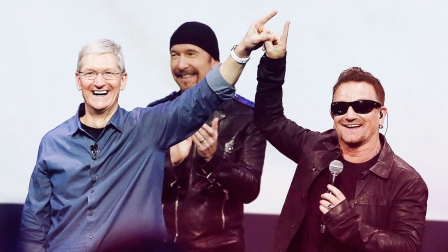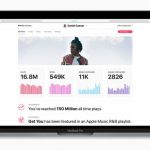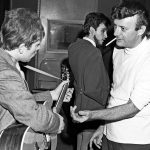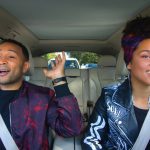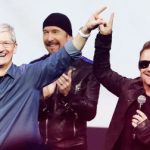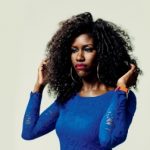Apple Music: Can Apple Outgrow Its “Lame Dad” Vibe?
September 9, 2014 was a pivotal day for Apple. On stage at the Flint Center in Cupertino, the company’s executives proudly revealed sleek, media-ready renderings of new gadgets, marking Apple’s biggest product lineup refresh in years: two new and bigger iPhones, a long-rumored smart watch, and Apple Pay, the company’s first foray into wireless mobile payments. As the two-hour flurry of announcements wound down, Apple CEO Tim Cook borrowed his predecessor’s “one more thing” schtick, albeit without uttering those exact words.
As the stage lights dimmed into a wash of blue and red, four figures appeared: U2, the ultra-famous Irish rock band who had forged a promotional relationship with Apple a decade earlier, took the stage to debut a new, never-before-heard song. After the performance, Cook engaged the band in a painfully scripted exchange leading to one more big reveal: Songs of Innocence, the band’s new album, would instantly and exclusively appear in the iTunes libraries of millions of Apple customers for free. “I can’t think of anyone they would like to have music from more,” Cook declared before closing out the event.
Although 33 million people reportedly accessed the album during its first week, not everyone shared Cook’s enthusiasm. Rather than making it available via the usual search-and-download delivery method, Apple made the album magically appear on people’s devices, whether they had asked for it or not. Suddenly, “the biggest release in the history of music,” as Cook described it onstage, became one of the most controversial.
Fellow artists chided U2 for seeming to validate the “music is free” mentality that makes the business so challenging for up-and-coming musicians. But most loudly of all, Apple customers complained about having music thrust upon them without their consent. The Washington Post referred to it as “rock-and-roll as dystopian junk mail” while Wired dismissed the strategy as “nothing more than spam with forced downloads” that “should be remembered as a monumental blunder of the tech industry.” Eventually, Apple caved and was forced to offer customers a special, one-click process for removing Songs of Innocence from their music libraries.
Underlying the raucous deluge of tweets criticizing the move was an unmistakable air of snobbery: U2, however legit and decorated their career may be, had evolved into a fairly uncool band who—especially to the ears of younger listeners—peddled generic-sounding “dad rock.” Or, as the Daily Dot termed it in a retrospective mapping the band’s fall from coolness, U2 had become “the new Nickelback”—harsh, if slightly unfair (was Nickelback ever cool?), shorthand for a popular band that has grown easier to mock than to admire.
It was, without a doubt, a low point for Apple’s street cred among the music savvy. But perhaps unbeknownst to the vocally disgruntled, Cupertino was busy plotting its comeback via a new music service with roots woven deep inside the music industry and an aim toward injecting the Apple brand back into the cultural conversation around music—this time without the Nickelback references.
How Apple Lost Its Cool
Once upon a time, Apple was practically synonymous with music. Four years after Steve Jobs returned as CEO—and after the colorful iMac failed to wow consumers hooked on cheaper Windows PCs—the company finally succeeded in grabbing mainstream attention. The iPod, a comparatively sleek and compact alternative to clunky MP3 players, was unveiled in 2001 and quickly started reeling consumers toward the Apple brand. By 2003, the iTunes Store offered an industry-approved alternative to illegal file-sharing and gave music fans an easy way to load those white rectangular devices with thousands of songs.
An ad campaign starring faceless silhouettes listening to artists like The Vines, Feist, Daft Punk, and yes, U2, helped cement the iPod’s little white earbuds as a cultural status symbol. The transition from compact discs to digital downloads was not only official and sanctioned by the music industry, but it was neatly packaged in minimalist design and accompanied by trendy tunes that spanned genres and demographic groups. Seemingly out of nowhere, the iPod became a must-have device.
Then Steve Jobs unveiled the iPhone at Macworld in 2007, wowing the crowd with a device that was actually, as Jobs spun it, three in one: a phone, an internet-browsing gadget, and an iPod. This combination, later augmented with infinite features by the advent of the App Store, would go on to propel Apple to previously unthinkable levels of success and historic profits. And the bonkers success of the iPhone had another, less obvious effect: It broadened Apple’s strategic and marketing focus, shifting it away from being so centered around music.
As the iOS ecosystem—and Apple’s insane profits—continued to grow, the fact that iPhones and iPads featured a native music app became an afterthought, if not forgotten entirely by those who started downloading all-you-can-stream music subscription apps like Rdio, Rhapsody, and Spotify. Ten years after the launch of the iPod, the device had morphed into a lower-power clone of the iPhone called the iPod Touch, with the classic, click-wheel iPod slowly fading from Apple’s product lineup. Meanwhile, iTunes bloated with features (ranging from its Genius playlist generator to movie rentals) and the software started feeling like a necessary evil—an unwieldy desktop application that, for whatever reason, was required for one to sync and manage their iOS devices.
As the music streaming revolution began, Apple focused its digital music strategy in odd places. In 2010, rather than preempting the U.S. launch of Spotify a year later with a streaming service of its own—something it could have easily done thanks to its 2009 acquisition of music streaming site Lala—Apple decided to launch a social network within iTunes called Ping, yet another bolt-on to its desktop Frankenstein. The feature was so underwhelming that it quickly became a textbook example of the rare Apple product flop—Cupertino’s Google Wave, if you will—and was later discontinued.
And in a move that now seems to foreshadow the U2 gaffe four years later, Jobs closed out Apple’s “very special” 2010 iPad launch event (guest starring Ping) by inviting Coldplay’s Chris Martin to grace the crowd with an intimate solo performance. Like U2, Martin was a hugely successful artist by all accounts, but one that the Telegraph called the “simpering windbag frontman” of “The World’s Most Boring Band,” whose presence at Apple’s launch event amounted to a decidedly unhip stain on the Apple brand. Ouch.
If you’re measuring purely with traditional music industry yardsticks—millions of albums sold, Grammys won, and so forth—bands like U2 and Coldplay are perfectly sensible additions to the product launch stage. But being a household name isn’t the same as being cool, especially in the eyes of music snobs or among that ever-coveted demographic of 18-24-year-old consumers. Toss these less-than-totally-hip artists onto a stage dominated by middle-aged white men (with or without their shirts fully tucked in) peddling computers and phones and, while you might have still have a recipe for selling millions of devices, you’re anything but cool.
Regardless of how one feels about U2, the 2014 album giveaway revealed a certain clumsiness about music distribution on Apple’s part. While Spotify was quickly becoming a household name and streaming was catching up with rapidly declining downloads, the company that legitimized digital music in the first place was enthusiastically shoving 11 songs onto the devices of millions of people who never asked for them. This strategy would likely have elicited a backlash about any artist, no matter how popular they were.
Apple Music: An Investment In Cultural Relevance
By mid-2015, Apple seemed to have learned some new lessons about how to reach young music fans. Even as U2 took the stage in September 2014, Apple was busy absorbing the talent and technology from its latest acquisition. Four months earlier, it dropped $3 billion on Beats Music and Beats Electronics, eliminating doubt that Apple saw a future in the all-you-can-stream music subscription model.
When it was finally ready to unveil its Apple Music subscription service last summer, it sandwiched Eddy Cue and his untucked button-down shirt between two new faces: Jimmy Iovine and the rapper Drake. Iovine, a newly minted Apple executive thanks to the Beats deal, brought with him decades of music industry cred, from his work engineering albums by John Lennon and Bruce Springsteen in the 1970s to the cofounding of Interscope Records and later Beats Electronics with hip-hop legend Dr. Dre (who also joined Apple). It soon became clear that Apple’s multi-billion-dollar investment was as much about people and relationships as it was about the mechanics of streaming songs to millions of listeners. With deep roots in the music industry—not to mention a massive pile of cash—Apple could launch a Spotify clone several years late, but with the help of very familiar faces. Faces like Drake’s.
Drake’s appearance at WWDC was symbolic of how serious Apple is about its renewed focus on music, but it was really just the beginning of a relationship that runs much deeper than a product endorsement. For a reported $19 million, Apple signed a deal with the much-hipper-than-U2 Drake that put his songs in Apple ads, his voice on Beats 1 Radio, and led to the successful (if somewhat controversial) Apple-exclusive release of Views, the Canadian rapper’s fourth studio album.
And it doesn’t stop with Drake. Other huge names are jumping on this exclusivity bandwagon, presumably for hard-to-resist sums of cash: Kanye West, most famously (and controversially) of all, dropped Life of Pablo exclusively on Jay-Z’s streaming service Tidal in February, before releasing it more broadly. Rihanna did the same with Anti. Just this weekend, Frank Ocean’s long and desperately awaited new album Blonde landed on Apple Music and iTunes and—unless you lived near one of the singer’s four pop-up shops erected to sell the album—wasn’t (legally) available anywhere else. In the days leading up to the release of Blonde, a Twitter search for “Apple Music” revealed results dominated by Frank Ocean—and vice versa. After the success of Ocean’s 2012 album Channel Orange, this was a conversation people were going to be having no matter what. Smartly, Apple managed to inject its brand right into the heart of it.
Increasingly, platform-exclusive releases like this serve as a competitive weapon wielded by services against one another in the so-called streaming wars. Thanks to the involvement of people like Iovine, Dre, and former Nine Inch Nails frontman Trent Reznor (all of whom have been involved with Beats since its pre-Apple days), the Cupertino tech giant is exceptionally well positioned to fight this particular battle. And it better be—its competitors are taking the same tack. Tidal relies heavily on music industry relationships and exclusive deals to lure subscribers. Spotify has responded to the trend by hiring people like artist manager Troy Carter and bolstering its own artist relations efforts.
Even so, at first glance, Apple Music might not seem to offer much to coax anyone who has already invested their subscription dollars in another service like Spotify. These days, there’s only so much excitement you can drum up with yet another library of tens of millions of on-demand songs, even if you nab exclusives from top-selling artists. But as you dig into the Apple Music app, it becomes clear Apple has been investing heavily in music curation and media partnerships designed to not only set itself apart from other streaming services, but give it what the company hopes is unparalleled credibility among music fans of all stripes.
It’s off to a decent start. Apple Music employs a small army of music programmers, eschewing Pandora-style algorithms in favor of playlists hand-built by people who truly know what they’re doing. These curators are tasked with building playlists as broad as an intro to David Bowie and as hyper-specific as Krautrock deep cuts and songs inspired by The Beach Boys. Apple Music playlists span artists and genres both universal and obscure, manually mapping relationships between songs and musicians and sequencing tracks as thoughtfully as a record store clerk who moonlights as a DJ. In short, they’re very good. It’s the sort of undertaking we’ve come to expect from machines, but instead this technology giant has thrown its resources at doing things the old-fashioned way.
Apple’s old-school strategy extends into Beats 1, the FM-style radio station headed by veteran BBC DJ Zane Lowe where listeners can hear shows hosted by musicians like Pharrell, Mike D, Dr Dre, Q-Tip, St. Vincent and, yes, Drake. Even Sir Elton John gets to play radio DJ, interviewing other artists, telling stories, and spinning songs he loves. Woven throughout Apple’s star-studded Internet radio programming are exclusive interviews and, increasingly, new music from some of the biggest names in the industry, especially hip-hop and R&B. Apple Music has also partnered with reputable music publishers like Pitchfork, The Fader, and Vice’s Noisey, relationships that offer more editorial credibility to Apple’s music programming and a promotional bonus: Naturally, music journalists and their employers are going to relentlessly hype their shows on the network, sending more new listeners to Beats 1 and Apple Music.
Apple may be showing up to the streaming party very late, but it’s rolling in with the coolest kids in town and enough cash to spring for the good stuff. Don’t expect to see Bono back on that stage in Cupertino anytime soon.
Read more stories from inside Tim Cook’s Apple:
- Playing The Long Game Inside Tim Cook’s Apple
- 9 Ways Tim Cook Has Transformed Apple
- Apple Music’s Bozoma Saint John: It’s About Passion, Not Algorithms
- Tim Cook On Apple’s Values, Mistakes, And Seeing Around Corners
- Why Cory Doctorow Thinks Apple’s Disappearing Headphone Jack Should Scare You
- The iPhone 7 Is Coming: Here’s Everything We’ve Heard So Far
- What I Learned Working With Jony Ive’s Team On The Apple Watch
- Four Reasons Why Betting Against Apple Is A Fool’s Game
- The Apple Watch 2: Everything We Know So Far
Fast Company , Read Full Story
(39)

